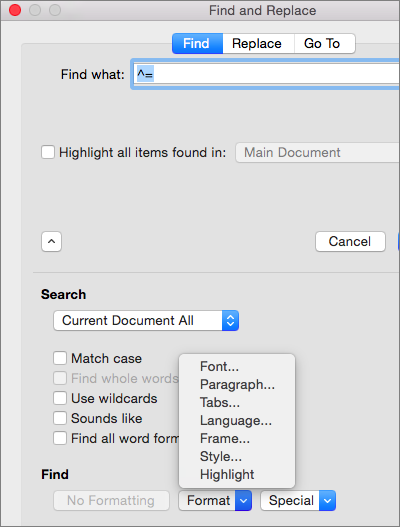Jun 19, 2018. In Word and Publisher. On the Home tab, in the Font group, click Clear All Formatting. In PowerPoint. On the Home tab, in the Font group, click Clear All Formatting. On the Message tab, in the Basic Text group, click Clear All Formatting. On the Home tab, in the Basic Text group, click Clear All Formatting.
- Reveal Formatting In Word 2016
- Formatting In Word 2016
- Reveal Formatting In Word 2016 For Mac Pdf
- Reveal Formatting In Word Mac
I recently had the opportunity to attend the 22nd national conference of ACES: The Society for Editing. One of my favorite sessions this year was presented by Rhonda Bracey of CyberText Consulting, who shared time-saving tips for Microsoft Word. Her blog is a great resource for shortcuts, formatting tips and other useful features.
Unfortunately for me and my MacBook, CyberText's tips are all written for Windows users. So for all you other Mac users out there, here are a few translations. The tips in this post are all ways to show hidden formatting in Word, which can help you diagnose problems when text doesn't look right or won't go where you want it to.
Reveal Formatting In Word 2016
The instructions below are for Microsoft Word for Mac, version 16. All of the options for showing formatting and styles will only show up on your screen—they will not affect the printed version of a document.
Formatting marks
Formatting marks may look like clutter if you aren't used to them, but they hold a lot of useful information. For example, uneven paragraph spacing could be caused by soft line breaks, section breaks or a style applied to a paragraph. With visible formatting marks, you can tell what is happening in your document at a glance. You can learn more about formatting marks, including what each symbol means, in the CyberText Newsletter. To turn these marks on and off, click the pilcrow icon (¶) on the Home ribbon or use the keyboard shortcut, ⌘ + 8.
Style labels
There are two ways to do this on a Mac. The simple way is to open the Styles Pane using the button on the far right of the Home ribbon. At the bottom of the Styles Pane, check the box to show styles guides. This will randomly assign a number and color as a label for each style. The labels will appear next to each style in the Style Pane and in the left margin next to each paragraph that uses the style.
If you would rather see the style names next to each paragraph, open the Preferences window from the main menu. Click 'View' and find the preference for 'style area width.' Increase the width to at least an inch (you can adjust it later if you want to change the size). Close the Preferences window and go back to the ribbon. Use the View ribbon to switch to Draft view. All of your paragraphs should now have style names listed next to them. You can return to the standard view by clicking 'Print Layout' on the far left of the View ribbon.
Bookmarks
Bookmarks are useful for creating links within a document or between multiple documents. To show bookmarks in your document, open Preferences, then click 'View' and check the bookmark box. This will put gray brackets around any bookmarked text.
Field Shading
Word has a few special features to help automate tasks like numbering pages and figures or creating a table of contents. These features look like normal text, but they are actually fields that Word fills in according to a set pattern. Entering text manually into these fields stops them from functioning correctly, so it's important to be able to distinguish them from normal text.
To make fields visible, open Preferences, then click 'View' and select your preference for field shading. Epiphone serial numbers meaning. Rhonda recommends always shading fields, but you can also opt to shade them only when they are selected.
Next time you find yourself struggling with stubborn formatting or misplaced links, try using these tips to uncover the problem.
Know any other great Word tricks? Tell us about them on Twitter.
Formatting In Word 2016
Related Links:
Reveal Formatting In Word 2016 For Mac Pdf
Posted May 26, 2011 by Rob Rogers in Microsoft Word
View special characters and formatting codes in Word.
Sometimes Word will just format things oddly and it's not really clear what is going on. Seeing the formatting codes will really help.
1. Go into the Format menu
2. Click Reveal Formatting
3. Under options in the Reveal Formatting window, select the Show all formatting marks check box.
Do this again to turn it off or just close the Reveal Formatting window.
Shortcut: SHIFT-F1 and then click on your text.
Word 2007/2010
1. Go to the Ribbon and select the Home tab.
2. Go to the Paragraph section of the Ribbon.
3. Select the Show/Hide button. Turn it off by selecting the Show/Hide button again.
If not all of the formatting marks disappear when you turn it off:
1. Click the File button .
2. Select Options.
3. From the left pane, select Display.
4. Find the Always show these formatting marks on the screen section and uncheck the corresponding checkmarks for the formatting marks.
5. Click the OK button.
Word for Mac 2008/2011
VIEW SPECIAL CHARACTERS —
Reveal Formatting In Word Mac
1. Click the Word menu
2. Click Preferences
3. Click View
4. Click All or your specific request under Nonprinting characters
5. Click OK
VIEW FORMATTING–
1. Click the View menu
2. Click the Reveal Formatting selection

3. Now click on the area to see the formatting of that area
About Rob Rogers
View more articles by Rob Rogers
The Conversation
Follow the reactions below and share your own thoughts.
